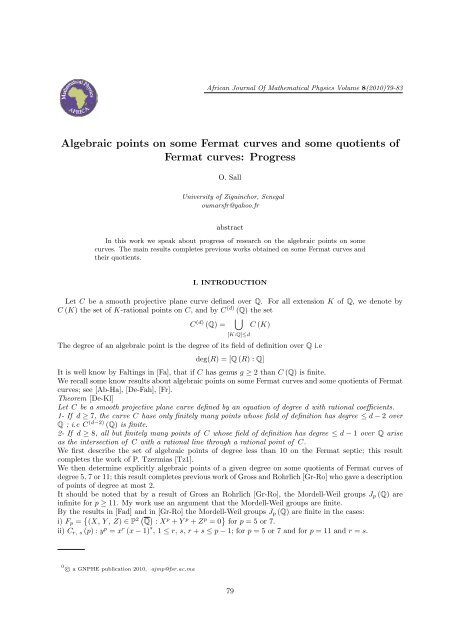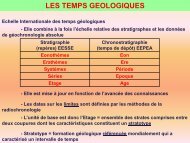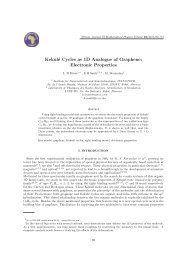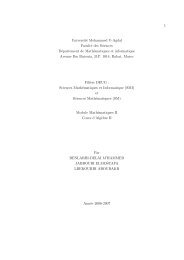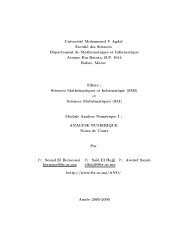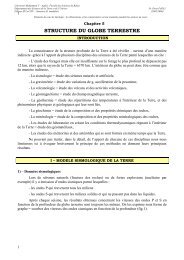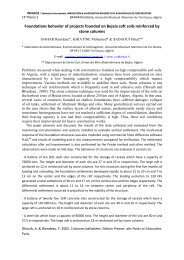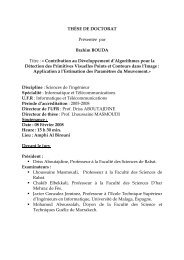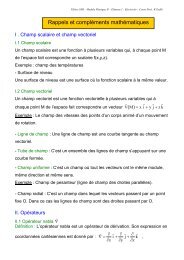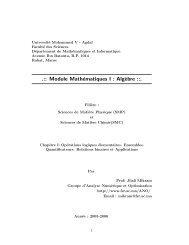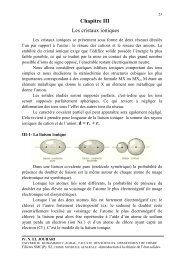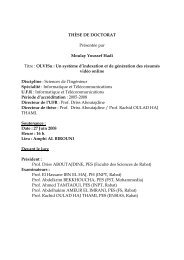Algebraic points on some Fermat curves and some quotients of ...
Algebraic points on some Fermat curves and some quotients of ...
Algebraic points on some Fermat curves and some quotients of ...
You also want an ePaper? Increase the reach of your titles
YUMPU automatically turns print PDFs into web optimized ePapers that Google loves.
African Journal Of Mathematical Physics Volume 8(2010)79-83<br />
<str<strong>on</strong>g>Algebraic</str<strong>on</strong>g> <str<strong>on</strong>g>points</str<strong>on</strong>g> <strong>on</strong> <strong>some</strong> <strong>Fermat</strong> <strong>curves</strong> <strong>and</strong> <strong>some</strong> <strong>quotients</strong> <strong>of</strong><br />
<strong>Fermat</strong> <strong>curves</strong>: Progress<br />
O. Sall<br />
University <strong>of</strong> Ziguinchor, Senegal<br />
oumarsfr@yahoo.fr<br />
abstract<br />
In this work we speak about progress <strong>of</strong> research <strong>on</strong> the algebraic <str<strong>on</strong>g>points</str<strong>on</strong>g> <strong>on</strong> <strong>some</strong><br />
<strong>curves</strong>. The main results completes previous works obtained <strong>on</strong> <strong>some</strong> <strong>Fermat</strong> <strong>curves</strong> <strong>and</strong><br />
their <strong>quotients</strong>.<br />
I. INTRODUCTION<br />
Let C be a smooth projective plane curve defined over Q. For all extensi<strong>on</strong> K <strong>of</strong> Q, we denote by<br />
C (K) the set <strong>of</strong> K-rati<strong>on</strong>al <str<strong>on</strong>g>points</str<strong>on</strong>g> <strong>on</strong> C, <strong>and</strong> by C (d) (Q) the set<br />
C (d) (Q) = ∪<br />
C (K)<br />
[K:Q]≤d<br />
The degree <strong>of</strong> an algebraic point is the degree <strong>of</strong> its field <strong>of</strong> definiti<strong>on</strong> over Q i.e<br />
deg(R) = [Q (R) : Q]<br />
It is well know by Faltings in [Fa], that if C has genus g ≥ 2 than C (Q) is finite.<br />
We recall <strong>some</strong> know results about algebraic <str<strong>on</strong>g>points</str<strong>on</strong>g> <strong>on</strong> <strong>some</strong> <strong>Fermat</strong> <strong>curves</strong> <strong>and</strong> <strong>some</strong> <strong>quotients</strong> <strong>of</strong> <strong>Fermat</strong><br />
<strong>curves</strong>; see [Ab-Ha], [De-Fah], [Fr].<br />
Theorem [De-Kl]<br />
Let C be a smooth projective plane curve defined by an equati<strong>on</strong> <strong>of</strong> degree d with rati<strong>on</strong>al coefficients.<br />
1- If d ≥ 7, the curve C hase <strong>on</strong>ly finitely many <str<strong>on</strong>g>points</str<strong>on</strong>g> whose field <strong>of</strong> definiti<strong>on</strong> has degree ≤ d − 2 over<br />
Q ; i.e C (d−2) (Q) is finite.<br />
2- If d ≥ 8, all but finitely many <str<strong>on</strong>g>points</str<strong>on</strong>g> <strong>of</strong> C whose field <strong>of</strong> definiti<strong>on</strong> has degree ≤ d − 1 over Q arise<br />
as the intersecti<strong>on</strong> <strong>of</strong> C with a rati<strong>on</strong>al line through a rati<strong>on</strong>al point <strong>of</strong> C.<br />
We first describe the set <strong>of</strong> algebraic <str<strong>on</strong>g>points</str<strong>on</strong>g> <strong>of</strong> degree less than 10 <strong>on</strong> the <strong>Fermat</strong> septic; this result<br />
completes the work <strong>of</strong> P. Tzermias [Tz1].<br />
We then determine explicitly algebraic <str<strong>on</strong>g>points</str<strong>on</strong>g> <strong>of</strong> a given degree <strong>on</strong> <strong>some</strong> <strong>quotients</strong> <strong>of</strong> <strong>Fermat</strong> <strong>curves</strong> <strong>of</strong><br />
degree 5, 7 or 11; this result completes previous work <strong>of</strong> Gross <strong>and</strong> Rohrlich [Gr-Ro] who gave a descripti<strong>on</strong><br />
<strong>of</strong> <str<strong>on</strong>g>points</str<strong>on</strong>g> <strong>of</strong> degree at most 2.<br />
It should be noted that by a result <strong>of</strong> Gross an Rohrlich [Gr-Ro], the Mordell-Weil groups Jp (Q) are<br />
infinite for p ≥ 11. My work use an argument that the Mordell-Weil groups are finite.<br />
By the results in [Fad] <strong>and</strong> in [Gr-Ro] the Mordell-Weil groups Jp (Q) are finite in the cases:<br />
i) Fp = { (X, Y , Z) ∈ P 2 ( Q ) : X p + Y p + Z p = 0 } for p = 5 or 7.<br />
ii) Cr, s (p) : y p = x r (x − 1) s , 1 ≤ r, s, r + s ≤ p − 1; for p = 5 or 7 <strong>and</strong> for p = 11 <strong>and</strong> r = s.<br />
0 c⃝ a GNPHE publicati<strong>on</strong> 2010, ajmp@fsr.ac.ma<br />
79
O. Sall African Journal Of Mathematical Physics Volume 8(2010)79-83<br />
II. WE STUDY ALGEBRAIC POINTS ON THE FERMAT SEPTIC, I.E ON THE SMOOTH<br />
PLANE CURVE<br />
F7 = { (X, Y , Z) ∈ P 2 ( Q ) : X 7 + Y 7 + Z 7 = 0 }<br />
In this work, which is based <strong>on</strong> [Tz1], we describe the set <strong>of</strong> algebraic <str<strong>on</strong>g>points</str<strong>on</strong>g> <strong>of</strong> degree less than 10 <strong>on</strong><br />
the <strong>Fermat</strong> septic. This result completes the work <strong>of</strong> Tzermias [Tz1].<br />
It has been c<strong>on</strong>jectured ( see for example [Kl-Tz]) that all <str<strong>on</strong>g>points</str<strong>on</strong>g> <strong>on</strong> the latter set lie <strong>on</strong> the line X +<br />
Y + Z = 0.<br />
By the work <strong>of</strong> Gross <strong>and</strong> Rohrlich [Gr-Ro], there are exactly five algebraic <str<strong>on</strong>g>points</str<strong>on</strong>g> <strong>of</strong> degree at most 3 <strong>on</strong><br />
F7, namely<br />
a = (0, − 1, 1); b = (−1, 0, 1), ∞ = (−1, 1, 0); p = (η, η, − 1), p = (η, η, − 1)<br />
where η is a primitive 6−th root <strong>of</strong> unity in Q, <strong>and</strong> η is the complex c<strong>on</strong>jugate <strong>of</strong> η. Note that the obove<br />
five <str<strong>on</strong>g>points</str<strong>on</strong>g> are the <strong>on</strong>ly <str<strong>on</strong>g>points</str<strong>on</strong>g> <strong>of</strong> intersecti<strong>on</strong> <strong>of</strong> F7 with the line X + Y + Z = 0.<br />
We recall <strong>some</strong> know results:<br />
F (3)<br />
7 (Q) = {a, b, ∞, p, p} [Gr-Ro]<br />
F (5)<br />
7 (Q) = {a, b, ∞, p, p} [Tz1]<br />
In [Sa1] we describe the set <strong>of</strong> algebraic <str<strong>on</strong>g>points</str<strong>on</strong>g> <strong>of</strong> degree less than 6 (resp. 4) <strong>on</strong> the <strong>Fermat</strong> curve <strong>of</strong><br />
degree 7 (resp. 5).<br />
Our main result is the following theorem:<br />
Theorem: The algebraic <str<strong>on</strong>g>points</str<strong>on</strong>g> <strong>of</strong> degree 6 (resp. 4) over Q <strong>on</strong> the <strong>Fermat</strong> curve <strong>of</strong> degree 7 (resp. 5)<br />
arise as the intersecti<strong>on</strong> <strong>of</strong> F7 (rep. F5) with a rati<strong>on</strong>al line through a, b or ∞.<br />
In [Sa3] we describe the set <strong>of</strong> algebraic <str<strong>on</strong>g>points</str<strong>on</strong>g> <strong>of</strong> degree at most 10 <strong>on</strong> the <strong>Fermat</strong> curve <strong>of</strong> degree 7.<br />
This work develops <strong>and</strong> generalizes our previous note [Sa1]. Our main result is the following theorem:<br />
Theorem: The algebraic <str<strong>on</strong>g>points</str<strong>on</strong>g> <strong>of</strong> degree 7 over Q <strong>on</strong> F7 arise as the intersecti<strong>on</strong> <strong>of</strong> F7 with a rati<strong>on</strong>al<br />
line.<br />
There is no algebraic <str<strong>on</strong>g>points</str<strong>on</strong>g> <strong>of</strong> degree 8 or 9 over Q <strong>on</strong> F7.<br />
The algebraic <str<strong>on</strong>g>points</str<strong>on</strong>g> <strong>of</strong> degree 10 over Q <strong>on</strong> F7 arise as the intersecti<strong>on</strong> <strong>of</strong> F7 with a rati<strong>on</strong>al c<strong>on</strong>ic C<br />
through {a, b} or {a, ∞} or {b, ∞}; i.e<br />
F7 .C = R1 + · · · + R10 +2Q 1 +2Q 2<br />
with Q1 ̸= Q2 <strong>and</strong> Q1, Q2 ∈ {a, b, ∞}; R1, · · · , R10 the Galois c<strong>on</strong>jugates <strong>of</strong> a point <strong>on</strong> F7 <strong>of</strong> degree 10<br />
over Q.<br />
III. WE DETERMINE EXPLICITLY ALGEBRAIC POINTS OF A GIVEN DEGREE ON<br />
SOME QUOTIENTS OF FERMAT CURVES:<br />
Cr, s (p) : y p = x r (x − 1) s<br />
p is an odd prime <strong>and</strong> r, s integers with 1 ≤ r, s, r + s ≤ p − 1.<br />
It is well know [see [Gr-Ro] , [Tz2]] that the latter <strong>curves</strong> Cr, s (p) : y p = x r (x − 1) s are the <strong>quotients</strong> <strong>of</strong><br />
<strong>Fermat</strong> <strong>curves</strong> Fp. We recall [see [Fad] <strong>and</strong> [Gr-Ro]] that the Mordell-Weil groups Jp (Q) are finite for<br />
p = 5 or 7 <strong>and</strong> for p = 11 <strong>and</strong> r = s.<br />
By the work <strong>of</strong> Gross <strong>and</strong> Rohrlich [Gr-Ro] Cr, s (5) <strong>and</strong> C1, 1 (5) are birati<strong>on</strong>ally equivalent over Q;<br />
Cr, s (7) <strong>and</strong> C1, 1 (7) are birati<strong>on</strong>ally equivalent over Q; or Cr, s (7) <strong>and</strong> C1, 2 (7) are birati<strong>on</strong>ally equivalent<br />
over Q.<br />
We will use the following notati<strong>on</strong>:<br />
P0 = (0, 0, 1); P1 = (1, 0, 1), P∞ = (1, 0, 0); Pη = (η, η, 1), P η = (η, η, 1)<br />
where η is a primitive 6−th root <strong>of</strong> unity in Q, <strong>and</strong> η is the complex c<strong>on</strong>jugate <strong>of</strong> η.<br />
1) <str<strong>on</strong>g>Algebraic</str<strong>on</strong>g> <str<strong>on</strong>g>points</str<strong>on</strong>g> <strong>on</strong> the curve<br />
C1, 2 (7) : y 7 = x (x − 1) 2<br />
80
O. Sall African Journal Of Mathematical Physics Volume 8(2010)79-83<br />
We determine the set <strong>of</strong> algebraic <str<strong>on</strong>g>points</str<strong>on</strong>g> <strong>of</strong> degree at most 3 <strong>on</strong> the Klein quartic curve. This result<br />
extends a previous result given by Hurwitz [Hu] who described the set <strong>of</strong> rati<strong>on</strong>al <str<strong>on</strong>g>points</str<strong>on</strong>g>.<br />
The curve C1, 2 (7) : y 7 = x (x − 1) 2 is birati<strong>on</strong>ally isomorphic to the Klein quartic curve given by the<br />
projective equati<strong>on</strong><br />
<strong>and</strong> the affine equati<strong>on</strong><br />
K : X 3 Y + Y 3 Z + Z 3 X = 0<br />
K : u 3 v + v 3 + u = 0<br />
This isomorphism is defined explicitly in projective coordinates by<br />
<strong>and</strong> in affine coordinates by<br />
<strong>and</strong> we have<br />
Ψ : K −→ C1, ( 2 (7)<br />
2 −XZ<br />
(X, Y , Z) ↦−→<br />
Y 3 , −X<br />
)<br />
, 1<br />
Y<br />
Ψ : K −→ C1, ( 2 (7) )<br />
−u −u<br />
(u, v) ↦−→ ,<br />
v3 v<br />
Ψ−1 : C1, 2 (7) −→ K(<br />
y<br />
(x, y) ↦−→<br />
7 + x2 − x<br />
(xy) 2 , 1 − x<br />
Theorem [Hurwitz [Hu]]: The set <strong>of</strong> rati<strong>on</strong>al <str<strong>on</strong>g>points</str<strong>on</strong>g> <strong>on</strong> C1, 2 (7) is<br />
C1 , 2 (7 ) (Q) = {P∞, P0 , P1 }.<br />
y3 )<br />
Theorem [Tzermias [Tz3]]: The set <strong>of</strong> quadratic <str<strong>on</strong>g>points</str<strong>on</strong>g> <strong>on</strong> C1, 2 (7) is<br />
O= { }<br />
Pη, P η .<br />
Our main result is the following theorem<br />
Theorem: The set <strong>of</strong> cubic <str<strong>on</strong>g>points</str<strong>on</strong>g> <strong>on</strong> C1, {<br />
2 (7) is the uni<strong>on</strong> <strong>of</strong> the following sets:<br />
P1 = (x, λ) | λ ∈ Q∗ , <strong>and</strong> x a root <strong>of</strong> x (x − 1) 2 = λ7 }<br />
;<br />
P2 = {( 1 + λy2 , y ) | λ ∈ Q∗ , <strong>and</strong> y a root <strong>of</strong> y3 = λ2 ( 1 + λy2)} ;<br />
P3 = {( 1 + λy3 , y ) | λ ∈ Q∗ , <strong>and</strong> y a root <strong>of</strong> y = λ2 ( 1 + λy3)} ;<br />
P4 = {( 1 + y4 , y ) | y a root <strong>of</strong> y3 + y2 − 1 = 0 } ;<br />
P5 = { (1 − y, y) | y a root <strong>of</strong> y3 + y2 − 1 = 0 } ;<br />
P6 = {( y3 − y2 + 1, y ) | y a root <strong>of</strong> y3 − 2y2 − y + 1 = 0 } ;<br />
P7 = {( −y2 , y ) | y a root <strong>of</strong> y3 + 2y2 + y + 1 = 0 } .<br />
On the Klein quartic curve K, we have:<br />
Theorem: The set <strong>of</strong> quadratic <str<strong>on</strong>g>points</str<strong>on</strong>g> <strong>on</strong> K is<br />
OK= { Ψ −1 (Pη) , Ψ −1 ( )}<br />
P η<br />
Ψ−1 (Pη) = (−η, − η, 1), Ψ−1 ( )<br />
P η = (−η, − η, 1).<br />
Theorem: The set <strong>of</strong> cubic <str<strong>on</strong>g>points</str<strong>on</strong>g> <strong>on</strong> K is the uni<strong>on</strong> <strong>of</strong> the following sets:<br />
A1 = { (u, v, 1 ) | v ∈ Q∗ , u3 v + u + v 3 = 0 } ;<br />
A2 = { (u, v, 1 ) | u ∈ Q∗ , u3 v + u + v 3 = 0 } ;<br />
A3 = { (s, 1 , t) | s ∈ Q∗ , t 3 s + t + s3 = 0 } ;<br />
81
O. Sall African Journal Of Mathematical Physics Volume 8(2010)79-83<br />
{(<br />
α 5 + α 4 + 1<br />
A4 =<br />
(1 + α4 2 , − α<br />
)<br />
{(<br />
α<br />
A5 =<br />
6 + α − 1 1<br />
2 ,<br />
α (1 − α) α2 )<br />
A6 =<br />
A7 =<br />
We have:<br />
)<br />
{(<br />
α 5 + α 4 − 2 α 3 + α 2 + α − 1<br />
{( α 5 + α 2 + 1<br />
α 4<br />
α (1 − α) 2<br />
, 1 + α2<br />
α 3<br />
| α a root <strong>of</strong> α 3 + α 2 − 1 = 0<br />
| α a root <strong>of</strong> α 3 + α 2 − 1 = 0<br />
)<br />
, 1 − α<br />
α<br />
)<br />
}<br />
;<br />
}<br />
;<br />
| α a root <strong>of</strong> α 3 − 2 α 2 − α + 1 = 0<br />
| α a root <strong>of</strong> α 3 + 2 α 2 + α + 1 = 0<br />
A4 = Ψ −1 (P4 ); A5 = Ψ −1 (P5 ); A6 = Ψ −1 (P6 ); A7 = Ψ −1 (P7 ).<br />
2) <str<strong>on</strong>g>Algebraic</str<strong>on</strong>g> <str<strong>on</strong>g>points</str<strong>on</strong>g> <strong>on</strong> the <strong>curves</strong><br />
C1, 1 (5); C1, 1 (7) <strong>and</strong> C1, 1 (11).<br />
We determine explicitly algebraic <str<strong>on</strong>g>points</str<strong>on</strong>g> <strong>of</strong> given degree <strong>on</strong> these <strong>curves</strong> for completes previous work <strong>of</strong><br />
Gross <strong>and</strong> Rohrlich [Gr-Ro] who gave a descripti<strong>on</strong> <strong>of</strong> <str<strong>on</strong>g>points</str<strong>on</strong>g> <strong>of</strong> degree at most two.<br />
Theorem [Goss <strong>and</strong> Rohrlich [Gr-Ro]]:<br />
C 2 {(<br />
1<br />
1 , 1 (p) (Q) =<br />
2 ±<br />
√<br />
y p + 1<br />
) }<br />
, y | y ∈ Q ∪ {P∞}<br />
4<br />
for p = 5, 7 or 11.<br />
Our main result is the following theorem<br />
Theorem: For p = 5, 7 or 11 <strong>and</strong> l ≥ 1, we have:<br />
with<br />
C l 1 , 1 (p) (Q) =<br />
⎛<br />
⎝ ∪<br />
0 ≤m≤p−1<br />
Nm<br />
⎞<br />
⎠ ∪<br />
⎛<br />
⎜<br />
⎝<br />
∪<br />
0 ≤δ≤ l<br />
2<br />
⎧ (<br />
⎪⎨<br />
−<br />
Nm=<br />
⎪⎩<br />
yp−m )<br />
g (y)<br />
l − m<br />
, y | h (y) ̸= 0, 0 ≤ deg(h) ≤ ,<br />
h (y)<br />
2<br />
l − p + m<br />
0 ≤ deg(g) ≤ , y a root <strong>of</strong><br />
2<br />
ym [h (y)] 2 − g (y) [yp−m ⎫<br />
⎪⎬<br />
⎪⎭<br />
g (y) + h (y)] = 0<br />
Mδ = {(x, y) | [Q [y] : Q] = δ <strong>and</strong> x a root <strong>of</strong> x (x − 1 ) = y p }.<br />
We finish by describing the subjacent principle <strong>of</strong> the method used for the dem<strong>on</strong>strati<strong>on</strong> <strong>of</strong> the principal<br />
theorems.<br />
One supposes given a point ∞ ∈ C(Q) <strong>and</strong> the jacobian embedding<br />
j : C −→ J<br />
P ↦−→ [P − ∞] .<br />
The method supposes that <strong>on</strong>e knows or determines the structure <strong>of</strong> the group J(Q) <strong>and</strong> that this <strong>on</strong>e<br />
be finite:<br />
J (Q) ≃ (Z/N1Z) × · · · × (Z/NsZ).<br />
One then chooses D1, · · · , Ds the dividers <strong>on</strong> C defined <strong>on</strong> Q such as j (Di) be the order Ni <strong>and</strong> j (D1),<br />
· · · , j (Ds) generate J(Q). If R is an algebraic point <strong>of</strong> degree k over Q <strong>and</strong> R1, · · · , Rk its Galois<br />
c<strong>on</strong>jugates, then j (R1 + · · · + Rk ) bel<strong>on</strong>gs to J(Q) <strong>and</strong> c<strong>on</strong>sequently it exists 0 ≤ mi ≤ Ni − 1 such as<br />
}<br />
.<br />
Mδ<br />
⎞<br />
⎟<br />
⎠<br />
j (R1 + · · · + Rk ) = m1j (D1) + · · · + ms j (Ds).<br />
The Abel-Jacobi theorem involves the existence <strong>of</strong> a rati<strong>on</strong>al functi<strong>on</strong> f defined <strong>on</strong> Q such as<br />
82<br />
}<br />
;
O. Sall African Journal Of Mathematical Physics Volume 8(2010)79-83<br />
R1 + · · · + Rk − m1 D1 − · · · − msDs +<br />
(<br />
∑<br />
1≤i≤s<br />
mi deg Di<br />
)<br />
− k ∞ = div (f).<br />
The functi<strong>on</strong> f thus has prescribed poles, <strong>and</strong> if <strong>on</strong>e knows how to analyze spaces<br />
L (D) = { f ∈ Q (C) | div (f) + D ≥ 0 }<br />
(note: if D is defined <strong>on</strong> Q then L Q (D) = LQ (D) ⊗ Q)<br />
i.e the linear system |D| = PL (D), <strong>on</strong>e can deduced the restricti<strong>on</strong>s <strong>on</strong> the Ri, <strong>and</strong> even in the good<br />
cases an explicit descripti<strong>on</strong>.<br />
REFERENCES<br />
[Ab-Ha] D. Abramovic, J. Harris, Abelian varieties <strong>and</strong> <strong>curves</strong> in Wd(C), Composio Math. 78 (1991)<br />
227-238.<br />
[De-Fah] O. Debarre, R. Fahlaoui, Abelian varieties <strong>and</strong> <strong>curves</strong> in W r d (C) <strong>and</strong> <str<strong>on</strong>g>points</str<strong>on</strong>g> <strong>of</strong> bounded degree<br />
<strong>on</strong> algebraic <strong>curves</strong>, Composio Math. 88 (1993) 235-249.<br />
[De-Kl] O. Debarre, M. Klassen, Points <strong>of</strong> low degree <strong>on</strong> smooth plane <strong>curves</strong>, J. Reine Angew. Math.<br />
446 (1994) 81-87.<br />
[Ed] E. F. Schaefer, Computing a Selmer group <strong>of</strong> a Jacobian using functi<strong>on</strong>s <strong>on</strong> the curve, Math. Ann.<br />
310 (1998) 447-471.<br />
[Fa] G. Faltings. Endlichkeitssätze für abelsche Varietäten über Zahlkörpern. Inv. Math. 73 (1983),<br />
349-366.<br />
[Fad] D. Faddeev, On the divisor class groups <strong>of</strong> <strong>some</strong> algebraic <strong>curves</strong>, Dokl. Akad. Nauk SSSR 136<br />
(1961) 296-298 [= Soviet. Math. Dokl. 2 (1) (1961) 67-69].<br />
[Fr] G. Frey, Curves with infinitely many <str<strong>on</strong>g>points</str<strong>on</strong>g> <strong>of</strong> fixed degree, Israel J. Math. 85 (1994) 79-83.<br />
[Gr-Ro] B. Gross, D. Rohrlich, Some results <strong>on</strong> the Mordell-Weil group <strong>of</strong> the Jacobian <strong>of</strong> the <strong>Fermat</strong><br />
curve, Invent. Math. 44 (1978) 201-224.<br />
[Hu] A. Hurwitz, Überdie diophantische Gleichung x3y + y3 + x = 0, Math. Ann. 65 (1908) 428-430<br />
[= Math. Werke II 427-429].<br />
[Kl-Tz] M. Klassen, P. Tzermias, <str<strong>on</strong>g>Algebraic</str<strong>on</strong>g> Points <strong>of</strong> low degree <strong>on</strong> the <strong>Fermat</strong> quintic, Acta Arith. 82<br />
(4) (1997) 393-401.<br />
[Tz1] P. Tzermias, <str<strong>on</strong>g>Algebraic</str<strong>on</strong>g> Points <strong>of</strong> low degree <strong>on</strong> the <strong>Fermat</strong> curve <strong>of</strong> degree seven, Manuscriptc<br />
Math. 97 (4) (1998) 483-488.<br />
[Tz2] P. Tzermias, Torsi<strong>on</strong> parts <strong>of</strong> Mordell-Weil groups <strong>of</strong> <strong>Fermat</strong> Jacobians, Internat. Math. Res.<br />
Notices 7 (1998) 359-369.<br />
[Tz3] P. Tzermias, low degree <str<strong>on</strong>g>points</str<strong>on</strong>g> <strong>on</strong> Hurwitz-Klein <strong>curves</strong>, preprint, (1999).<br />
[Sa1] O. Sall, Points algébriques de petit degré sur les courbes de <strong>Fermat</strong>, C. R. Acad. Sci. Paris Série<br />
I, t. 330 (2000) 67-70.<br />
[Sa2] O. Sall, Points algébriques sur certains <strong>quotients</strong> de courbes de <strong>Fermat</strong>, C. R. Acad. Sci. Paris<br />
Série I, t. 336 (2003) 117-120.<br />
[Sa3] O. Sall, Points algébriques de degré au plus 10 sur la septique de <strong>Fermat</strong>, Afrika Matematika, Série<br />
3, volume 15 (2003) 49-55.<br />
83


